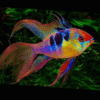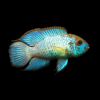-
×

-
×

-
×

-
×

Subtotal: £98.72













Emily Carter (verified owner) –
As a passionate aquarium enthusiast, I couldn’t be happier with my pair of Apistogramma Agassizii «Double Red». These beautiful dwarf cichlids have been a stunning addition to my 30-gallon tank. After just a week of them settling in, the male has already started showing off his vibrant colors, flaunting those rich red fins that truly stand out against the aquascape.
The female is just as lovely, and I’ve noticed her exploring the hiding spots I created with plants and driftwood. It’s heartwarming to see how they interact; they seem to have formed a close bond! These cichlids are known to be a bit shy, and I’ve taken care to keep the tank calm, which I think has helped them adapt quickly.
Compared to other cichlids I’ve kept, the Agassizii are much more personable and curious, making them a joy to watch. I also appreciate how they’re relatively peaceful towards other species, as long as they have places to retreat when needed. My only minor concern is that they can be a bit temperamental during breeding, so I’ll need to keep an eye on that as they mature. If you’re a fellow aquarist looking for beautiful, engaging freshwater fish, I highly recommend investing in this pair. They’ve brought so much life to my tank, and I can’t wait to see how they thrive!
Emily Carter (verified owner) –
I recently purchased a pair of Apistogramma Agassizii «Double Red» and I couldn’t be happier with my choice! These dwarf cichlids are such vibrant additions to my community tank. After about two months of observation, I have noticed their colors becoming even more pronounced, especially when they’re displaying their dominance or during feeding time. It’s pure joy to watch them interact!
I initially considered bringing home different types of freshwater fish, but the Agassizii stood out because of their unique coloring and personality. They are so much more engaging than my previous fish!
One thing to note is that they do need a bit of cover in the tank—plants and caves are a must for them to feel secure. I quickly added some driftwood and floating plants, and it has made a huge difference.
I’d recommend this pair for any intermediate aquarist looking to add personality to their aquarium. They bring life and color that truly enhances the beauty of the setup. My experience ordering was smooth—arrived healthy and well-packaged. I’d definitely buy from here again!